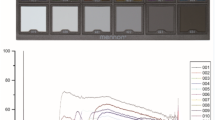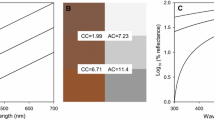Abstract
Spectrophotometers allow the objective measurement of colour and as a result are rapidly becoming a key piece of equipment in the study of animal colouration; however, they also have some major limitations. For example, they can only record point samples, making it difficult to reconstruct topographical information, and they generally require subjects to be inanimate during measurement. Recently, the use of digital cameras has been explored as an alternative to spectrophotometry. In particular, this allows whole scenes to be captured and objectively converted to animal colour space, providing spatial (and potentially temporal) data that would be unobtainable using spectrophotometry; however, mapping between camera and animal colour spaces requires knowledge of the spectral sensitivity functions of the camera’s sensors. This information is rarely available, and making direct measures of sensor sensitivity can be prohibitively expensive, technically demanding and time-consuming. As a result, various methods have been developed in the engineering and computing sciences that allow sensor sensitivity functions to be estimated using only readily collected data on the camera’s response to a limited number of colour patches of known surface reflectance. Here, I describe the practical application of one such method and demonstrate how it allows the recovery of sensor sensitivities (including in the ultraviolet) with a high enough degree of accuracy to reconstruct whole images in terms of the quantal catches of an animal’s photoreceptors, with calculated values that closely match those determined from spectrophotometric measurements. I discuss the potential for this method to advance our understanding of animal colouration.



Similar content being viewed by others
References
Alsam A, Lenz R (2007) Calibrating color cameras using metameric blacks. J Opt Soc Am A 24:11–17
Barbosa A, Mäthger LM, Buresch KC, Kelly J, Chubb C, Chiao C-C, Hanlon RT (2008) Cuttlefish camouflage: the effects of substrate contrast and size in evoking uniform, mottle or disruptive body patterns. Vis Res 48:1242–1253
Barnard K (1995) Computational color constancy: taking theory into practice. Master’s thesis, Simon Fraser University
Beddard FE (1892) Animal coloration: an account of the principle facts and theories relating to the colours and markings of animals. Swan Sonnenschein, London
Bennett A, Cuthill I, Norris K (1994) Sexual selection and the mismeasure of color. Am Nat 144:848–860
Bennett ATD, Cuthill IC, Partridge JC, Maier EJ (1996) Ultraviolet vision and mate choice in zebra finches. Nature 380:433–435
Bergman TJ, Beehner JC (2008) A simple method for measuring colour in wild animals: validation and use on chest patch colour in geladas (Theropithecus gelada). Biol J Linn Soc 94:231–240
Chiao C-C, Osorio D, Vorobyev M, Cronin TW (2000) Characterisation of natural illuminants in forests and the use of digital video data to reconstruct illuminant spectra. J Opt Soc Am A 17:1713–1721
Chiao C-C, Chubb C, Buresch KC, Siemann L, Hanlon RT (2009) The scaling effects of substrate texture on camouflage patterning in cuttlefish. Vis Res 49:1647–1653
Ebner M (2007) Estimating the spectral sensitivity of a digital sensor using calibration targets. Proceedings of the 9th annual conference on genetic and evolutionary computation, London, 7–11 July 2007, ACM, New York, pp 642–649A
Endler JA (1990) On the measurement and classification of colour in studies of animal colour patterns. Biol J Linn Soc 41:315–352
Endler J, Mielke P (2005) Comparing entire colour patterns as birds see them. Biol J Linn Soc 86:405–431
Farrell JE, Wandell BA (1993) Scanner linearity. J Electron Imaging 23:225–230
Finlayson GD, Hordley S, Hubel PM (1998) Recovering device sensitivities with quadratic programming. IS&T/SID sixth color imaging conference: color science, systems and applications, Scottsdale, Arizona, Nov 1998, pp 90–95
Frischknecht M (1993) The breeding coloration of male threespined sticklebacks (Gasterosteus aculeatus) as an indicator of energy investment in vigour. Evol Ecol 7:439–450
Govardovskii VI, Fyhrquist N, Reuter T, Kuzmin DG, Donner K (2000) In search of the visual pigment template. Vis Neurosci 17:509–528
Hardeberg JY, Brettel H, Schimitt F (1998) Spectral characterization of electronic cameras. Proc SPIE 3409:100–109
Hart NS, Partridge JC, Cuthill IC, Bennett ATD (2000) Visual pigments, oil droplets, ocular media and cone photoreceptor distribution in two species of passerine bird: the blue tit (Parus caeruleus L.) and the blackbird (Turdus merula L.). J Comp Physiol A 186:375–387
Higham JP, Brent LJN, Dubuc C, Accamando AK, Engelhardt A, Gerald MS, Heistermann M, Stevens M (2010) Color signal information content and the eye of the beholder: a case study in the rhesus macaque. Behav Ecol 21:739–746
Hill G, McGraw KJ (2006) Bird coloration: function and evolution. Harvard University Press, Cambridge
Hubel PM, Sherman D, Farrell JE (1994) A comparison of methods of sensor spectral sensitivity estimation. Proc. IS&T/SID. 2nd color imaging conference: color science, systems and applications, pp 45–48
Huynh CP, Robles-Kelly A (2007) Comparative colorimetric simulation and evaluation of digital cameras using spectroscopy data. Digital image computing techniques and applications, 9th biennial conference of the Australian pattern recognition society, pp 309–316
Kohonen O, Parkkinen J, Jääskeläinen T (2006) Databases for spectral color science. Col Res Appl 31:381–390
Lovell PG, Tolhurst DJ, Párraga CA, Baddeley R, Leonards U, Troscianko J, Troscianko T (2005) Stability of the color-opponent signals under changes of illuminant in natural scenes. J Opt Soc Am A 22:2060–2071
McCamy CS, Marcus H, Davidson JG (1976) A color rendition chart. J Appl Photogr Eng 2:95–99
Osorio D, Vorobyev M, Jones CD (1999) Colour vision of domestic chicks. J Exp Biol 202:2951–2959
Parkkinen JPS, Hallikainen J, Jääskeläinen T (1989) Characteristic spectra of Munsell colors. J Opt Soc Am 6:318–322
Párraga CA (2003) Is the human visual system optimised for encoding the statistical information of natural scenes? PhD Thesis, University of Bristol
Poulton EB (1890) The colours of animals: their meaning and use, especially considered in the case of insects. Kegan Paul, London
Romero J, Valero E, Hernández-Andrés J, Nieves JL (2003) Color-signal filtering in the Fourier-frequency domain. J Opt Soc Am 20:1714–1724
Rush VN, McKinnon JS, Abney MA, Sargent RC (2003) Reflectance spectra from free-swimming sticklebacks (Gasterosteus aculeatus): social context and eye–jaw contrast. Behaviour 140:1003–1019
Ruxton GD, Speed MP, Sherratt TN (2004) Avoiding attack. The evolutionary ecology of crypsis, warning signals and mimicry. Oxford University Press, Oxford
Sharma G, Trussell HJ (1993) Characterization of scanner sensitivity. Proc. IS&T/SID color imaging conference: transforms and portability of color, pp 103–107
Sharma G, Trussell HJ (1996) Set theoretic estimation in color scanner characterization. J Electron Imaging 5:479–489
Solli M, Andersson M, Lenz R, Kruse B (2005) Color measurements with a consumer digital camera using spectral estimation techniques. Lect Notes Comput Sci 3540:105–114
Stevens M, Cuthill IC (2005) The unsuitability of HTML-based colour charts for estimating animal colours—a comment on Berggren and Merilä (2004). Front Zool 2:14
Stevens M, Cuthill IC (2006) Disruptive coloration, crypsis and edge detection in early visual processing. Proc R Soc B 273:2141–2147
Stevens M, Párraga CA, Cuthill IC, Partridge JC, Troscianko TS (2007) Using digital photography to study animal coloration. Biol J Linn Soc 90:211–237
Stoddard MC, Stevens M (2009) Pattern mimicry of host eggs by the common cuckoo, as seen through a bird’s eye. Proc R Soc B 277:1387–1393
Thomson M, Westland S (2001) Color-imager characterisation by parametric fitting of sensor responses. Col Res Appl 26:442–449
Vora P, Farrell J, Tietz J, Brainard D (1997) Digital color cameras 2—spectral response. Technical report HPL-97–54, HP Laboratories
Vorobyev M, Marshall J, Osorio D, Hempel de Ibarra N, Menzel R (2001) Colourful objects through animal eyes. Col Res Appl 6:214–217
Westland S, Ripamonti C (2004) Computation colour science using MATLAB. John Wiley & Sons, Chichester
Acknowledgements
I thank Stuart Townley and Laurel Fogarty for the discussion on the mathematical aspects of this paper and three anonymous referees for their extremely helpful comments on an earlier version. This work was supported by a NERC fellowship (NE/F016514/1).
Author information
Authors and Affiliations
Corresponding author
Additional information
Communicated by K. McGraw
Electronic supplementary material
Below is the link to the electronic supplementary material.
ESM 1
(DOC 41 kb)
Rights and permissions
About this article
Cite this article
Pike, T.W. Using digital cameras to investigate animal colouration: estimating sensor sensitivity functions. Behav Ecol Sociobiol 65, 849–858 (2011). https://doi.org/10.1007/s00265-010-1097-7
Received:
Revised:
Accepted:
Published:
Issue Date:
DOI: https://doi.org/10.1007/s00265-010-1097-7




